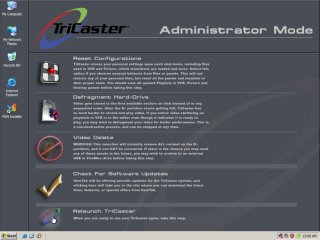

These pictures are taken from a Tricaster TC-100, the first model in the series, designed in 2005 (my unit is stamped 2006, but seems to be running the original 1.0 software.)
I wrote these screenshot pages as my collection grew, and I hate repeating myself, so since I got the Tricaster Pro before this one, please review that page to get the gist of the Tricaster interface. This page will mostly detail the deltas from that version.
In summary however: While the VT software that predated the Tricasters (detailed here) offered a lot of flexibility and depth, the Tricaster UI is very simplistic, and particularly so for this first model. While VT[4] (the current version of the Newtek VT software when this product was released) was designed for maximum capability, the Tricaster was meant to do just a few, very simple tasks, and cost as little as possible.
The specific reason I got a TC100 at all - since it's basically just a crappier TC Pro - is because I had heard that Newtek "dumbed down" the interface for amateurs. That turns out to be accurate: it is an extremely barebones UI, and Newtek removed as much broadcast industry terminology as they could. I will detail this below.
As with other Tricasters, this is meant to be an "appliance." While they didn't bother replacing the Windows XP splash screen (as they did with the Pro,) as soon as Windows boots, the Tricaster software starts up in fullscreen. You can't reach the desktop or run any other applications unless you go to the shutdown menu and select "Admin." That drops you to this desktop.
That wallpaper is actually Active Desktop. It's one of the only times I've ever seen it used for real. I should warn you: That link that says it'll delete all your video files? It will almost certainly do it without asking "are you sure" first.
This is the main switcher interface. As mentioned, I'm going to explain this in terms of what differs vs. the Tricaster Pro (which represented the Tricaster series for far longer than the original, I suspect.
First, some of the "professional" terminology has been replaced with more "approachable" terms:
Also, there are a number of UI changes - although to be fair, some of these are things that didn't exist in VT[4], and simply hadn't been added yet since VT[5] wasn't out.
As with the TC Pro, you can load title cards as templates, then edit the text as seen in the lower left here. This allows you to create a single title, then modify it for each broadcast without needing to use a full-blown editor.
However, there is no CG editor here at all. If you want titles other than the included templates, I guess you have to design them with a standalone app on a separate PC.
As with the TC Pro, the Background generator lets you save various types of gradients as presets and use them as a virtual input.
The Tricaster can perform keying, and just like in VT[4] (the current version of the VT software that was out at this time) it can do either chroma key, luma key or "linear" key. In VT[5] (and the TC Pro software that came out concurrently with it) Newtek removed these options in favor of "LiveMatte," their new chromakey implementation (which a lot of people apparently hated.)
On the one hand, chromakey has pretty much replaced the other methods in all fields as far as I know, but on the other, it's weird that Newtek removed finished features.
You may notice that the keyer does not specify an input. Unlike the TC Pro, you can't set keyer values per-input, it's either on or off. This seems super awkward, but I think it was actually the case in VT[4] at the time as well.
The Input tab allows you to set brightness/contrast/hue ("Proc Amp") values for each input.
As with the TC Pro, you can use an iVGA screencast streamed from another PC over a network as an input, and you can output the whole production to a connected projector (or other monitor) scaled to its native resolution. The "Keying" options allow you to overlay the iVGA input on the Projector output at original resolution, instead of scaled to standard def first.
Stream and capture work exactly like the TC Pro, except that the TC100 can only record in NT25, a proprietary (really?) codec from Newtek. They provided a Windows codec for converting it. Still, wow, that's weird.
Finally, some pics of the editing interface. This is actually the least "dumbed down" part of the whole system - VT Edit / SpeedEdit as included in VT[4] and VT[5] were pretty capable NLEs, and I'm not sure Newtek actually removed anything here, to their credit. If you know NLEs you can probably make out what's going on above. Can you tell I'm running out of steam to detail all this stuff?